Preparation and Properties of Waterborne Epoxy-Resin-Emulsified Asphalt Modified by Oxidized Extraction Oil
Abstract
:1. Introduction
2. Materials and Methods
2.1. Materials
2.2. Preparation Process
2.2.1. Extraction Oil Oxidation Pretreatment

2.2.2. Preparation of Extraction Oil/Waterborne Epoxy Resin System
2.2.3. Preparation of Extraction Oil/Waterborne Epoxy-Resin-Emulsified Asphalt
2.3. Characterizations
3. Results and Discussion
3.1. Performance Analysis of Oxidized Extraction Oil
3.1.1. FTIR
3.1.2. Emulsion Properties Comparison of Extraction Oil before and after Oxidation
3.2. Extraction Oil/Waterborne Epoxy Resin System
3.2.1. Emulsion Properties
3.2.2. Viscosity
3.2.3. Mechanical Properties
3.2.4. Compatibility
3.3. Oxidized Extraction Oil/Waterborne Epoxy-Resin-Emulsified Asphalt System
3.3.1. Viscosity
3.3.2. Mechanical Properties
3.3.3. Aging Performance
3.3.4. Compatibility
3.3.5. Microstructure of Extracted Oil/WEREA during Curing
4. Conclusions
5. Limitations
Author Contributions
Funding
Conflicts of Interest
References
- Cong, L.; Yang, F.; Guo, G.H.; Ren, M.; Shi, J.C.; Tan, L. The use of polyurethane for asphalt pavement engineering applications. Constr. Build. Mater. 2019, 225, 1012–1025. [Google Scholar] [CrossRef]
- Filho, W.U.; Gutiérrez Klinsky, L.M.; Motta, R.; Bariani Bernucci, L.L. Cold Recycled Asphalt Mixture using 100% RAP with Emulsified Asphalt-Recycling Agent as a New Pavement Base Course. Adv. Mater. Sci. Eng. 2020, 2020, 5863458. [Google Scholar] [CrossRef] [Green Version]
- Fu, H.; Wang, C.H.; Niu, L.L.; Yang, G.L.; Liu, L.Q. Composition optimisation and performance evaluation of waterborne epoxy resin emulsified asphalt tack coat binder for pavement. Int. J. Pavement Eng. 2021, 19, 4034–4048. [Google Scholar] [CrossRef]
- Shan, L.; Yang, H.; Tian, D.; Tan, Y. Evaluation of Anti-icing Emulsified Asphalt Binders. Front. Mater. 2020, 7, 257. [Google Scholar] [CrossRef]
- Yu, H.; Sun, L.; Liu, L.; Jia, L. Pavement Performance of Cold Recycling Sulphur Asphalt Mixture with Emulsified Asphalt. Adv. Mater. Res. 2011, 255, 3287–3291. [Google Scholar] [CrossRef]
- Arimilli, S.; Jain, P.; Nagabhushana, M. Optimization of Recycled Asphalt Pavement in Cold Emulsified Mixtures by Mechanistic Characterization. J. Mater. Civil. Eng. 2016, 28, 795–806. [Google Scholar] [CrossRef]
- Zhou, X.; Chen, L.; Cao, H.; Yu, J.; Qiu, G.; Wang, L. Effects of emulsified asphalt on the mechanical and tribological properties of copper/graphite composites. Mater. Res. Express 2019, 6, 266–274. [Google Scholar] [CrossRef]
- Jiang, Y.; Lin, H.; Han, Z.; Deng, C. Fatigue Properties of Cold-Recycled Emulsified Asphalt Mixtures Fabricated by Different Compaction Methods. Sustainability 2019, 11, 3483. [Google Scholar] [CrossRef] [Green Version]
- Pi, Y.; Li, Y.; Pi, Y.; Huang, Z.; Li, Z. Strength and Micro-Mechanism Analysis of Cement-Emulsified Asphalt Cold Recycled Mixture. Materials 2019, 13, 128. [Google Scholar] [CrossRef] [PubMed] [Green Version]
- Jiang, J.J.; Ni, F.; Zheng, J.Q.; Han, Y.J.; Zhao, X. Improving the high-temperature performance of cold recycled mixtures by polymer-modified asphalt emulsion. Int. J. Pavement Eng. 2018, 21, 41–48. [Google Scholar] [CrossRef]
- Xu, C.; Zhang, Z.Q.; Zhao, F.Q.; Liu, F.F.; Wang, J.R. Improving the performance of RET modified asphalt with the addition of polyurethane prepolymer (PUP). Constr. Build. Mater. 2019, 206, 560–575. [Google Scholar] [CrossRef]
- Ziari, H.; Keymanesh, M.; Zalnezhad, H. Effect of emulsifying agent on rheological properties of bitumen emulsion modified with different techniques of adding SBR latex polymer. Road Mater. Pavement 2020, 23, 639–655. [Google Scholar] [CrossRef]
- Liu, F.Q.; Zheng, M.L.; Fan, X.P. Properties and mechanism of waterborne epoxy resin-SBR composite modified emulsified asphalt. Constr. Build. Mater. 2021, 274, 122059. [Google Scholar] [CrossRef]
- Yang, G.L.; Wang, C.H.; Fu, H.; Yan, Z.B.; Yin, W.Y. Waterborne Epoxy Resin–Polyurethane–Emulsified Asphalt: Preparation and Properties. J. Mater. Civil. Eng. 2019, 31, 04019265. [Google Scholar] [CrossRef]
- Cai, X.; Huang, W.; Liang, J.; Wu, K. Study of Pavement Performance of Thin-Coat Waterborne epoxy resin emulsified asphalt Mixture. Front. Mater. 2020, 7, 259–271. [Google Scholar] [CrossRef]
- Wang, Y.; Gan, H.; Liang, C.; Zhang, Z.; Xie, M.; Xing, J.; Xue, Y.; Liu, H. Network structure and properties of crosslinked bio-based epoxy resin composite: An in-silico multiscale strategy with dynamic curing reaction process. Giant 2021, 7, 665–671. [Google Scholar] [CrossRef]
- Li, W.; Xu, G.L.; Xu, B.Q.; Wang, Y.; Yang, J.; Hu, J. Preparation of waterborne P-N containing epoxy resin curing and its performances. Pigm. Resin Technol. 2016, 45, 308–312. [Google Scholar] [CrossRef]
- Sheng, J.; Zeng, P.; Shan, Y. Study on the Synthesis and Properties of Waterborne Epoxy Resin and Curing Agent. Adv. Mater. Res. 2013, 815, 547–551. [Google Scholar] [CrossRef]
- Gu, Y.; Tang, B.; He, L.H.; Yang, F.; Wang, H.; Ling, J.M. Compatibility of cured phase-inversion waterborne epoxy resin emulsified asphalt. Constr. Build. Mater. 2019, 229, 175–185. [Google Scholar] [CrossRef]
- Zhang, Q.; Xu, Y.H. Influence of water-borne epoxy resin content on performance of waterborne epoxy resin compound SBR modified emulsified asphalt for tack coat. Constr. Build. Mater. 2017, 153, 774–782. [Google Scholar] [CrossRef]
- Bi, Y.; Li, R.; Han, S.; Pei, J.; Zhang, J. Development and Performance Evaluation of Cold-Patching Materials Using Waterborne Epoxy-Emulsified Asphalt Mixtures. Materials 2020, 13, 1224. [Google Scholar] [CrossRef] [PubMed] [Green Version]
- Liu, F.; Zheng, M.; Liu, X.; Ding, X.; Wang, F.; Wang, Q. Performance evaluation of waterborne epoxy resin-SBR composite modified emulsified asphalt fog seal. Constr. Build. Mater. 2021, 301, 89–104. [Google Scholar] [CrossRef]
- Yin, Y.; Han, S.; Kong, H.; Han, X.; Guo, H. Optimization and performance evaluation of waterborne epoxy resin modified emulsified asphalt micro-surfacing based on tunnel driving environment. Constr. Build. Mater. 2022, 315, 125604. [Google Scholar] [CrossRef]
- Zhao, H.; Xu, S.; Guo, A.; Li, J.; Liu, D. The Curing Kinetics Analysis of Four Epoxy Resins Using a Diamine Terminated Polyether as Curing Agent. Thermochim. Acta 2021, 702, 125–130. [Google Scholar] [CrossRef]
- Chen, C.; Eisenhut, W.O.; Lau, K.; Buss, A.; Bors, J. Performance characteristics of epoxy asphalt paving material for thin orthotropic steel plate decks. Int. J. Pavement Eng. 2018, 21, 397–407. [Google Scholar] [CrossRef]
- Jiang, X.; Gabrielson, J.; Huang, B.S.; Bai, Y.; Polaczyk, P.; Zhang, M.M.; Hu, W.; Xiao, R. Evaluation of inverted pavement by structural condition indicators from falling weight deflectometer. Constr. Build. Mater. 2022, 319, 125991. [Google Scholar] [CrossRef]
- Su, W.; Han, X.; Gong, J.; Xi, Z.; Zhang, J.; Wang, Q.; Xie, H. Toughening epoxy asphalt binder using core-shell rubber nanoparticles. Constr. Build. Mater. 2020, 258, 119716. [Google Scholar] [CrossRef]
- Xu, P.; Cong, P.; Li, D.; Zhu, X. Toughness modification of hyperbranched polyester on epoxy asphalt. Constr. Build. Mater. 2016, 122, 473–477. [Google Scholar] [CrossRef]
- Zhang, J.L. Effect of basalt chopped fiber on properties of epoxy asphalt and its mixture. Silic. Bull. 2020, 39, 3032–3039. [Google Scholar]
- Xiang, Q.; Xiao, F. Applications of epoxy materials in pavement engineering. Constr. Build. Mater. 2020, 235, 119716. [Google Scholar] [CrossRef]
- Du, X.; Xu, P.; Cong, P.; Zhou, Z. Compatibilization and toughness modification of linear aliphatic epoxy compound on paving epoxy asphalt. Mater. Struct. 2020, 53, 42. [Google Scholar] [CrossRef]
- Cong, P.L. Effects of epoxy resin contents on the rheological properties of epoxy-asphalt blends. J. Appl. Polym. Sci. 2010, 118, 3678–3684. [Google Scholar]
- Kang, Y.; Song, M.; Pu, L.; Liu, T. Rheological behaviors of epoxy asphalt binder in comparison of base asphalt binder and SBS modified asphalt binder. Constr. Build. Mater. 2015, 76, 343–350. [Google Scholar] [CrossRef]
- Si, J.; Li, Y.; Wang, J.; Niyigena, A.R.; Yu, X.; Jiang, R. Improving the compatibility of cold-mixed epoxy asphalt based on the epoxidized soybean oil. Constr. Build. Mater. 2020, 243, 118235. [Google Scholar] [CrossRef]
- Luo, T.; Liu, Q.; Xu, Z.; Sun, X.; Zhao, S. A novel characterization of furfural-extract oil from vacuum gas oil and its application in solvent extraction process. Fuel Process. Technol. 2016, 152, 356–366. [Google Scholar] [CrossRef]
- Li, G.; Ou, Y.; Xu, H. Experimental study on the production of road asphalt by blending furfural extracted oil. Pet. Asph. 2015, 29, 29–34. [Google Scholar]
- Ji, J.; Sun, P.; Huang, H. Analysis of the influence of furfural extracted oil on the performance of road asphalt. Pet. Asph. 2013, 27, 6–9. [Google Scholar]
- Si, J.; Jia, Z.; Wang, J.; Yu, X.; Li, Y.; Dong, F.; Jiang, R. Comparative analysis of cold-mixed epoxy and epoxy SBS-modified asphalts: Curing rheology, thermal, and mechanical properties. Constr. Build. Mater. 2018, 176, 165–171. [Google Scholar] [CrossRef]




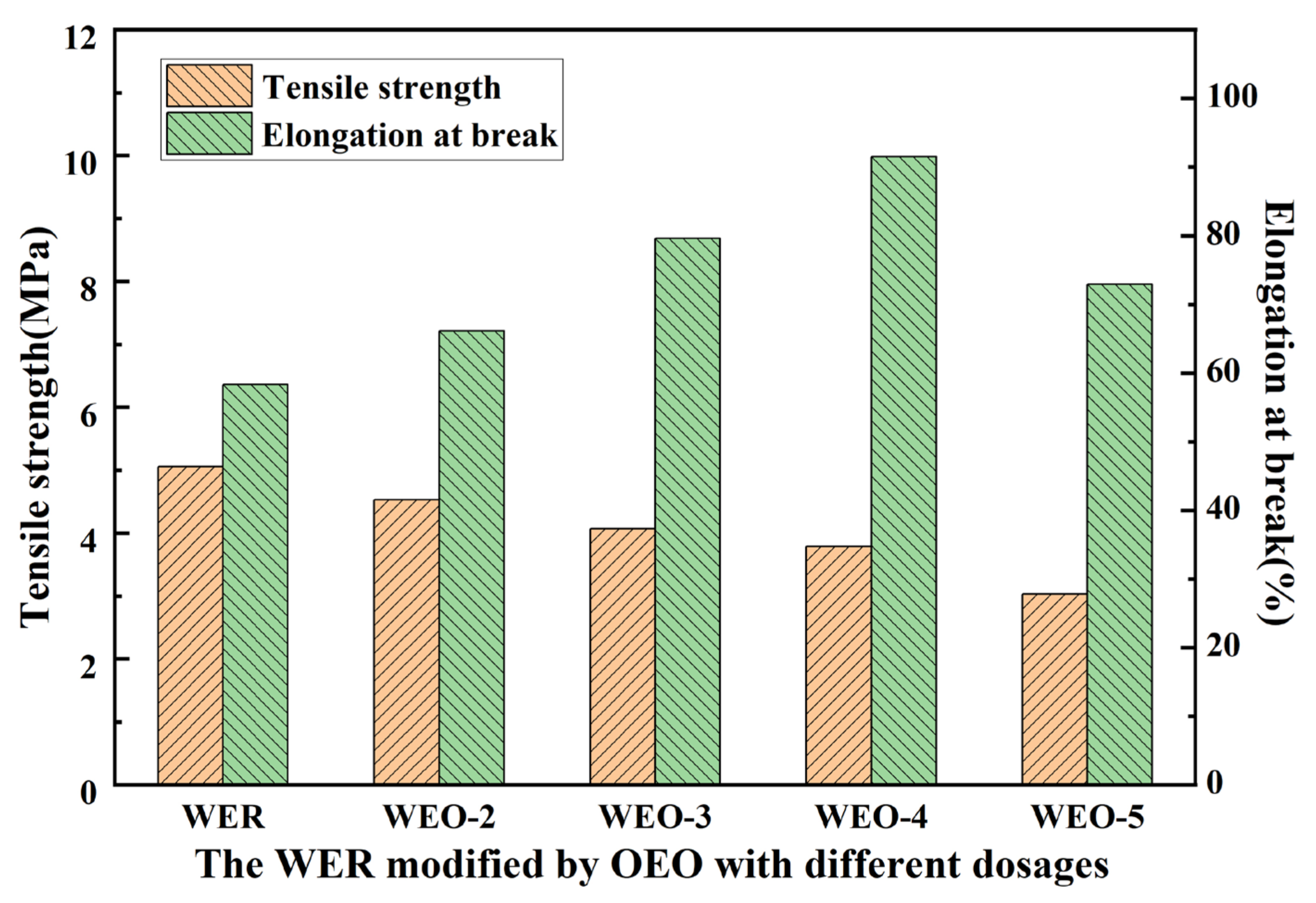
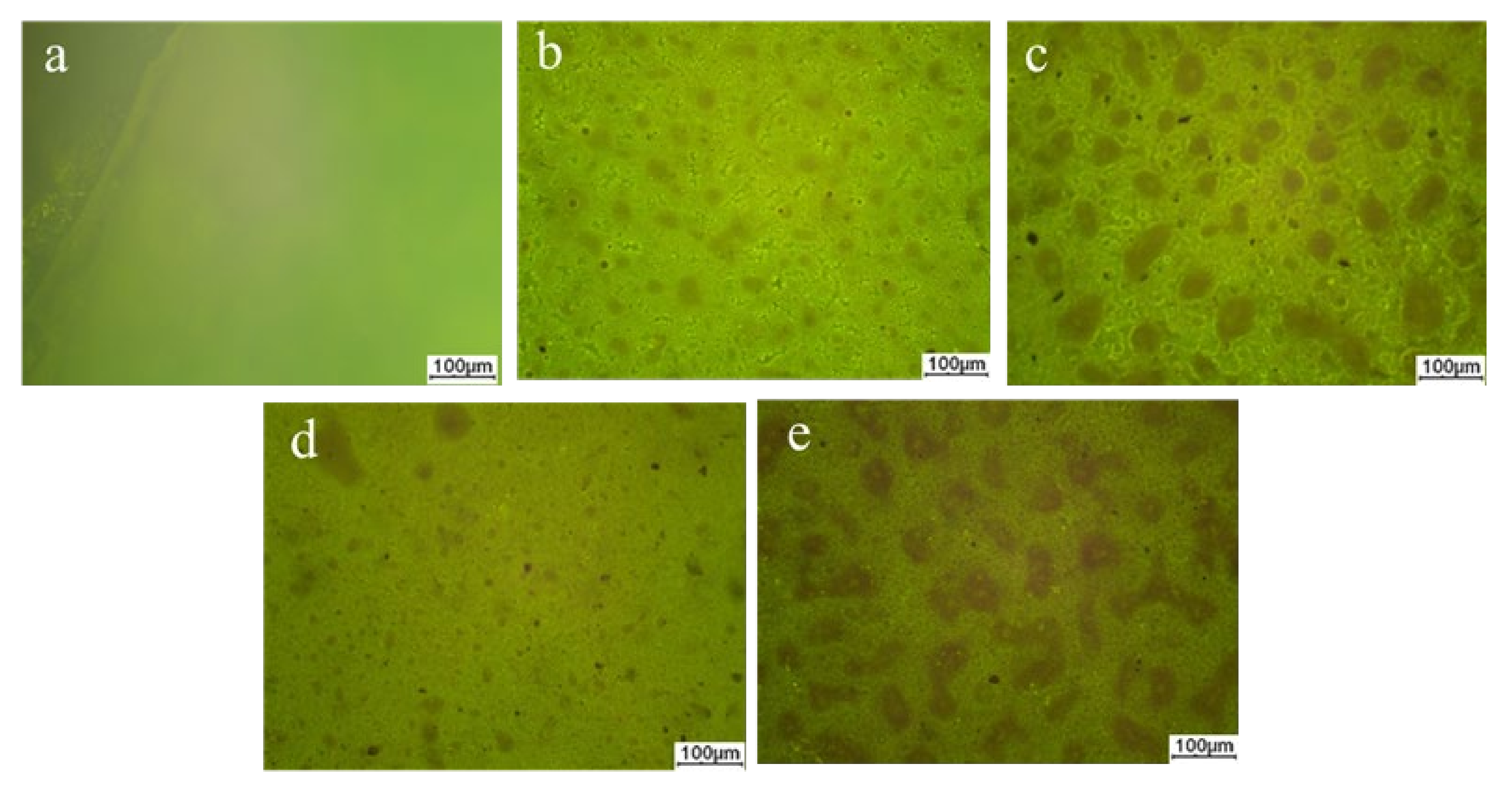
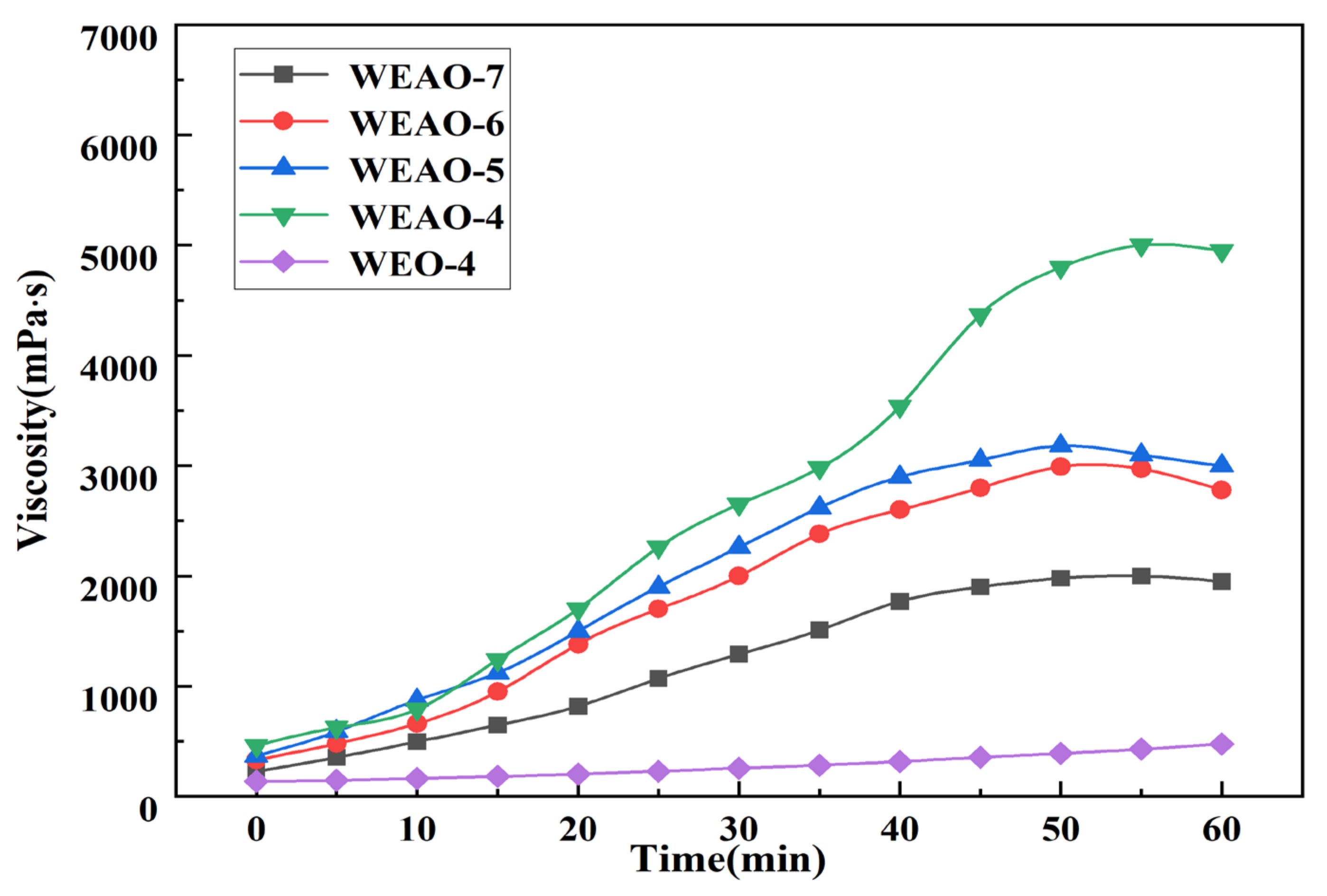
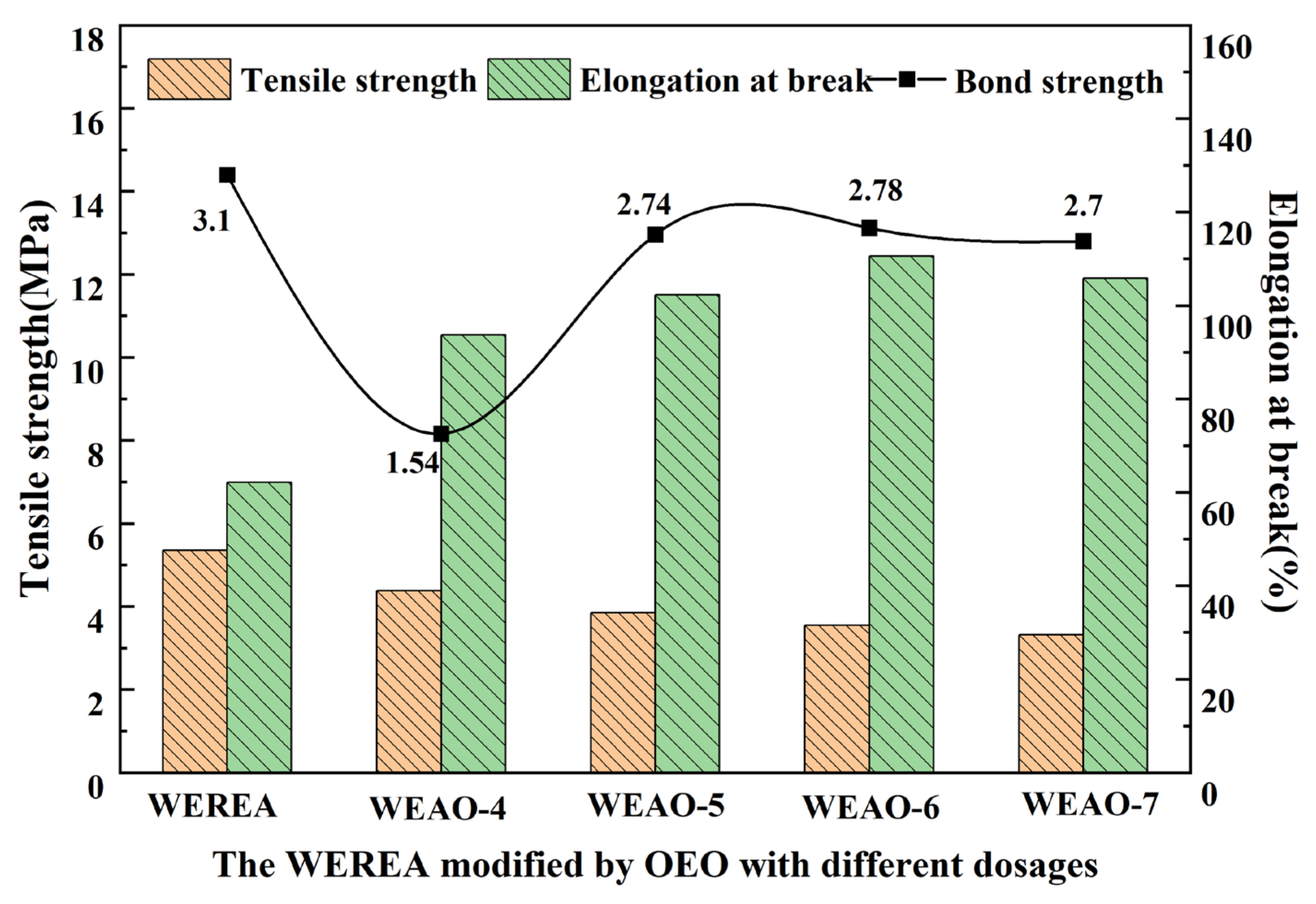

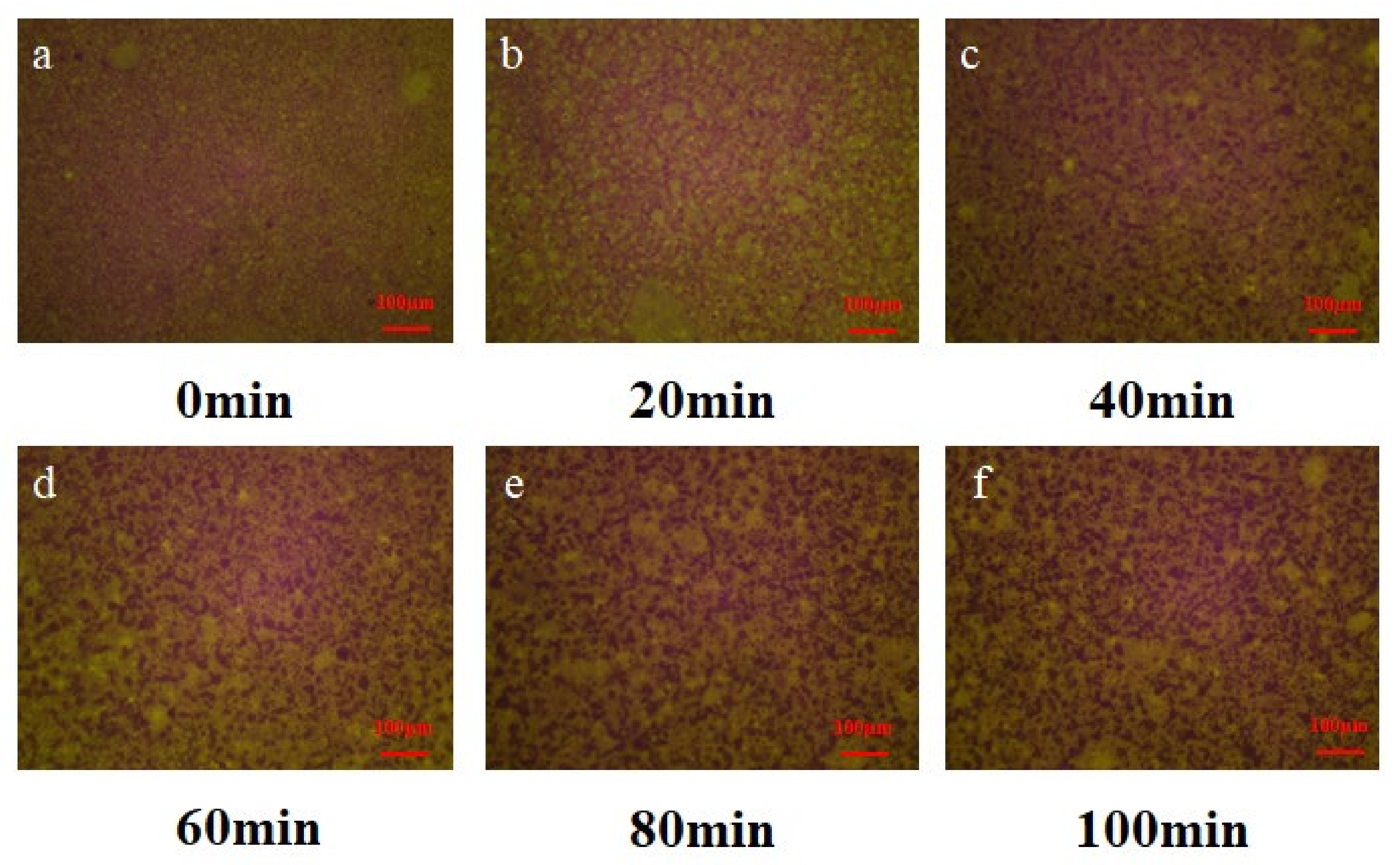
| Samples | Epoxy Resin | Curing Agent | Emulsified Asphalt | Oxidized Extraction Oil | Deionized Water |
|---|---|---|---|---|---|
| WEREA | 5 | 5 | 5 | 0 | 6.67 |
| WEAO-4 | 5 | 5 | 5 | 4 | 9.33 |
| WEAO-5 | 5 | 5 | 5 | 5 | 10 |
| WEAO-6 | 5 | 5 | 5 | 6 | 10.67 |
| WEAO-7 | 5 | 5 | 5 | 7 | 11.33 |
| Properties | EO/WER Emulsion | OEO/WER Emulsion |
|---|---|---|
| Shear difficulty | Difficult | Easy |
| Emulsion uniformity | Homogeneous | Non-homogeneous |
| Stability | Layered, separated | Stable |
| Samples | Shear Difficulty | Appearance | Drying Time/h | Film Forming Property | |
|---|---|---|---|---|---|
| Surface Dry Time | Real Drying Time | ||||
| WER | Easy | Homogeneous, no-stratification | 4 | 22 | Good |
| WEO-2 | Easy | Homogeneous, no-stratification | 4.2 | 22.3 | Good |
| WEO-3 | Easy | Homogeneous, no-stratification | 4.8 | 23 | Good |
| WEO-4 | Easy | Homogeneous, no-stratification | 5.3 | 23.5 | Good |
| WEO-5 | Relatively easy | Relatively non-homogeneous slight segregation | 6 | 24.2 | Fairly good |
| Samples | Tensile Strength (MPa) | Elongation at Break (%) | ||||
|---|---|---|---|---|---|---|
| Before Aging | After Aging | Loss Ratio | Before Aging | After Aging | Loss Ratio | |
| WEREA | 5.36 | 4.91 | 8.4% | 62.12 | 53.61 | 13.7% |
| WEAO-4 | 4.34 | 4.04 | 7.76% | 93.72 | 86.94 | 7.23% |
| WEAO-5 | 3.85 | 3.57 | 7.27% | 102.25 | 96.24 | 5.9% |
| WEAO-6 | 3.55 | 3.31 | 6.76% | 110.6 | 105.1 | 4.97% |
| WEAO-7 | 3.32 | 3.12 | 6.02% | 105.88 | 100.86 | 4.74% |
Publisher’s Note: MDPI stays neutral with regard to jurisdictional claims in published maps and institutional affiliations. |
© 2022 by the authors. Licensee MDPI, Basel, Switzerland. This article is an open access article distributed under the terms and conditions of the Creative Commons Attribution (CC BY) license (https://creativecommons.org/licenses/by/4.0/).
Share and Cite
Ai, T.; Pang, H.; Wu, X.; Zhong, D.; Yang, K.; Yan, X.; Niu, Y. Preparation and Properties of Waterborne Epoxy-Resin-Emulsified Asphalt Modified by Oxidized Extraction Oil. Buildings 2022, 12, 2133. https://doi.org/10.3390/buildings12122133
Ai T, Pang H, Wu X, Zhong D, Yang K, Yan X, Niu Y. Preparation and Properties of Waterborne Epoxy-Resin-Emulsified Asphalt Modified by Oxidized Extraction Oil. Buildings. 2022; 12(12):2133. https://doi.org/10.3390/buildings12122133
Chicago/Turabian StyleAi, Tao, Hua Pang, Xuanxuan Wu, Danni Zhong, Kun Yang, Xin Yan, and Yanhui Niu. 2022. "Preparation and Properties of Waterborne Epoxy-Resin-Emulsified Asphalt Modified by Oxidized Extraction Oil" Buildings 12, no. 12: 2133. https://doi.org/10.3390/buildings12122133
APA StyleAi, T., Pang, H., Wu, X., Zhong, D., Yang, K., Yan, X., & Niu, Y. (2022). Preparation and Properties of Waterborne Epoxy-Resin-Emulsified Asphalt Modified by Oxidized Extraction Oil. Buildings, 12(12), 2133. https://doi.org/10.3390/buildings12122133







